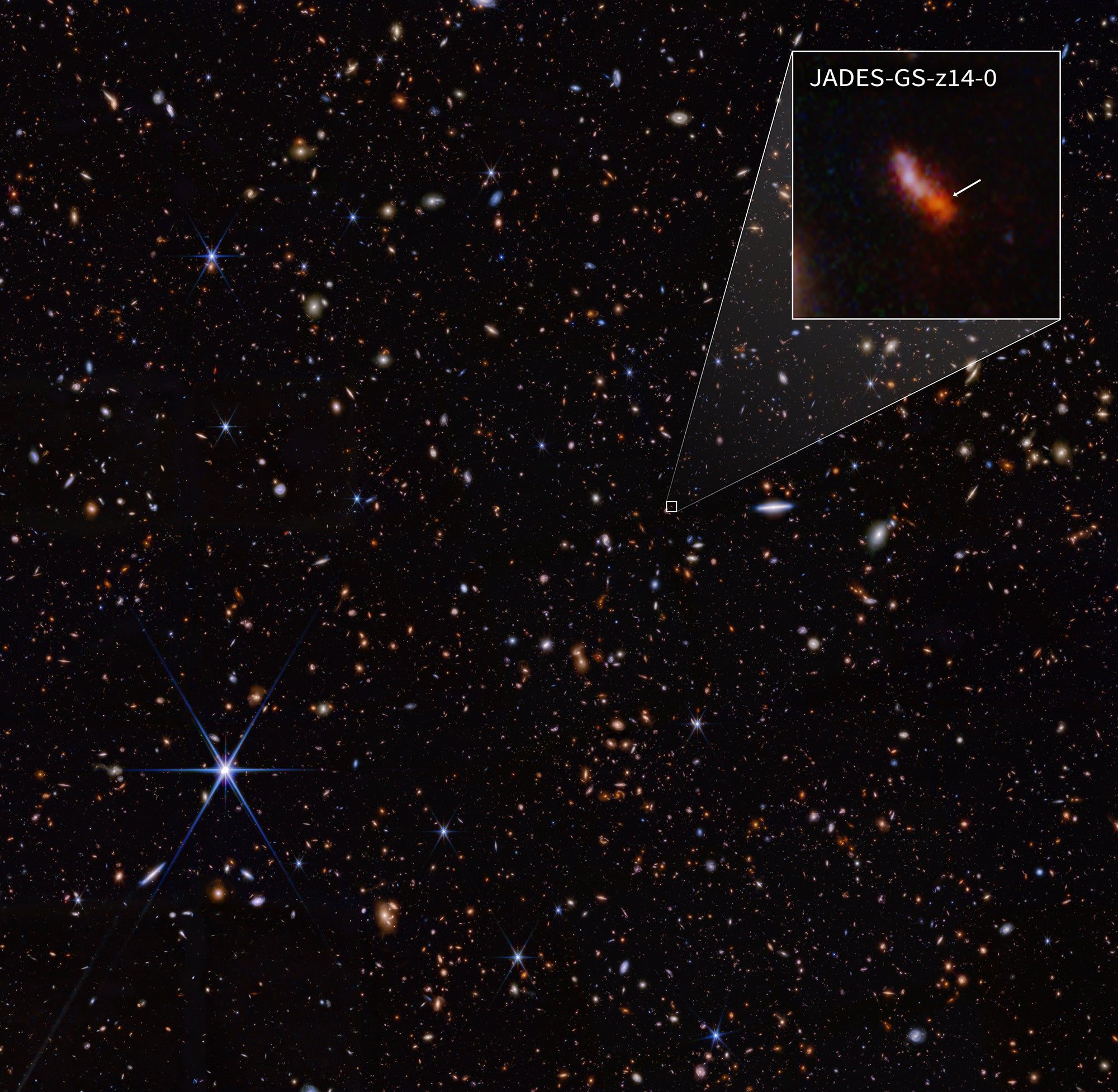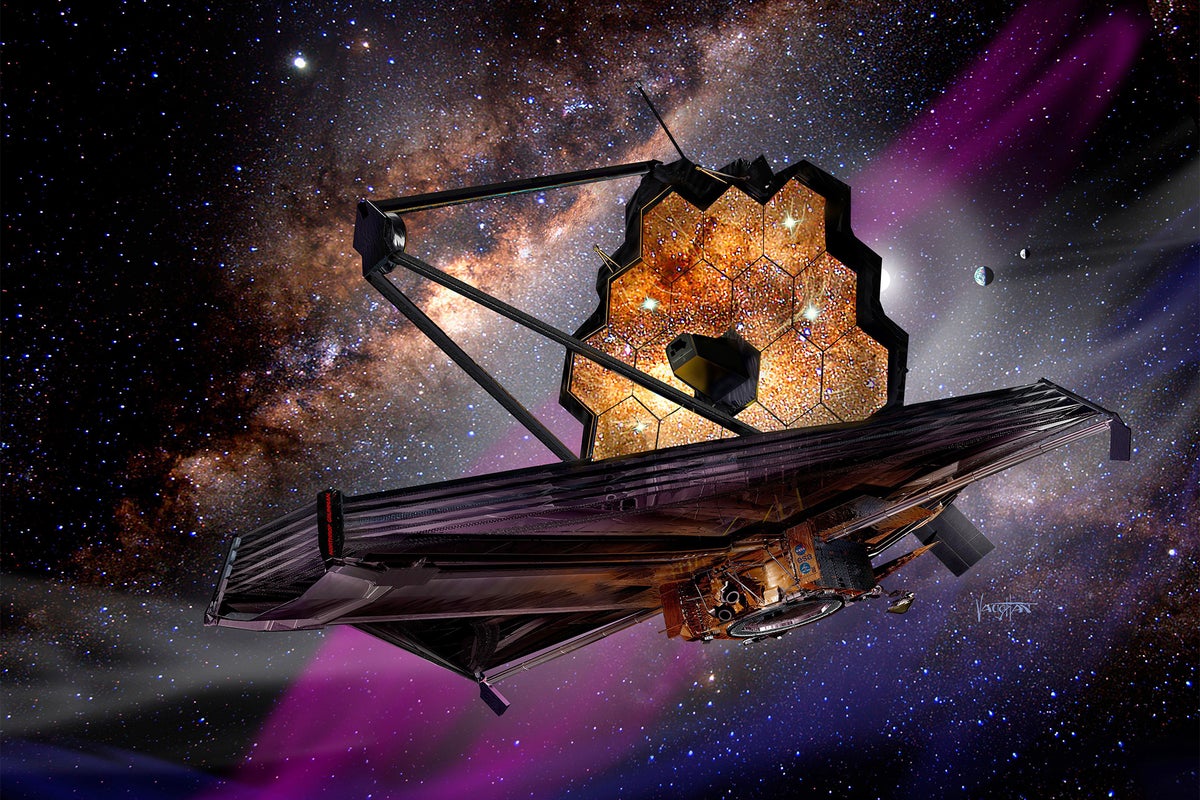NASA’s James Webb Space Telescope observed an unusually large and highly luminous galaxy at a record-breaking 290 million years after the big bang
Kevin Hainline can time travel from his desk. Well, he can’t physically launch himself back in time. But as a user of NASA’s James Webb Space Telescope (JWST), the University of Arizona astronomer regularly observes galaxies from billions of years ago—because it takes that long for their emitted light to reach us from across the cosmos. And recently, he tracked one further back into the universe’s history than ever before.
The record-breaking galaxy, named JADES-GS-z14-0, appears to us as it existed 290 million years after the big bang, when the universe was a mere 2 percent of its present 13.8-billion-year age. This places it well within a mysterious epoch called the cosmic dawn—when the universe’s first stars began to shine and galaxies coalesced. The former record holder, a galaxy named JADES-GS-z13-0 that was reported in 2022 by Hainline and his colleagues on the JWST Advanced Deep Extragalactic Survey (JADES) research team, was observed about 325 million years following the big bang. Hainline acknowledges this age difference may seem unremarkable; cosmically speaking, not a lot usually happens in just 35 million years. But JADES-GS-z14-0 has properties that are vastly different from its slightly older counterpart, making it an anomaly that has experts second-guessing how the universe’s first galaxies evolved. “I was skeptical that it was anything special for a number of reasons,” Hainline recalls of his initial glimpse of the galaxy. “It just seemed too big and too bright.... But in January of this year, when we confirmed that it is, in fact, the new record holder, I just laughed. I had to get up from my office chair and walk down the hallway and look at the faces of the other JADES scientists.”
The group’s initial doubts were well-founded, says Brant Robertson, an astronomer and JADES member at the University of California, Santa Cruz, who is also a co-author of the preprint paper that reported the new record holder. JWST has been unveiling candidate early galaxies that seem to shatter experts’ expectations since it began operating in early 2022, but some of them were ultimately proved to be impostors—more modern galaxies much closer to us in the universe than JWST’s first glance would suggest. Unsurprisingly, Robertson says, the farthest galaxies are the hardest to accurately observe and verify; their qualities can be the most fascinating yet deserve the most skepticism.
JADES-GS-z14-0 was no exception to this rule; at first, Hainline thought it was just one half of another galaxy. With closer examination, he found that to be illusory. The other galaxy was a “foreground” object—an entirely different system billions of light-years closer to us that just happened to overlap with JADES-GS-z14-0 in our line of sight. With that relationship untangled, the candidate’s bizarre qualities became clearer: if it was an early galaxy, JADES-GS-z14-0 was abnormally large and unusually shaped. “At that point I had been looking at thousands of little smudgy galaxies,” Hainline says. “But then this one came along, and I sent it first to my colleague Jake Helton [of the University of Arizona] and said, ‘This is seriously weird.’ And after looking into it more for some time, I knew we had to get a spectrum on it.”

NASA’s James Webb Space Telescope (JWST) captured this deep field image for the JWST Advanced Deep Extragalactic Survey, or JADES, program. Almost every object visible in this picture is a far-distant galaxy. Follow-up measurements have revealed that one in particular, JADES-GS-z14-0 (shown in the pullout), is the most distant known galaxy; we see it here as it appeared some 290 million years after the big bang.
NASA, ESA, CSA, STScI, B. Robertson (UC Santa Cruz), B. Johnson (CfA), S. Tacchella (Cambridge), P. Cargile (CfA)
Generated by an instrument called a spectrograph, a spectrum serves as a sort of cosmic barcode—an image of light split into all of its various wavelengths, or colors, that scientists can study to reveal otherwise hidden details, such as an object’s distance from Earth.
“JWST has a spectrograph that takes the light from these distant galaxies and disperses it like a prism does into its component wavelengths to make a rainbow, basically,” Robertson says. “Based on the features of that rainbow, we can tell how far away a galaxy is. It’s pretty much how we always confirm the distance of any faraway system.”
Scientists use the spectrum of a galaxy to then calculate its cosmological redshift—a numerical value that represents the stretching of light from shorter, bluer wavelengths to longer, redder ones that is caused by the expansion of space itself between a light source and an observer. The farther away an object is, the faster it is receding because of cosmic expansion, and the higher its redshift becomes. Every celestial object visible to the naked eye is too close to exhibit this effect and thus has a redshift of zero. A redshift of one corresponds to a distance of more than 10 billion light-years. JWST’s studies showed that JADES-GS-z14-0 has a redshift of 14.32, the highest ever recorded. (JADES-GS-z13-0 has a redshift of 13.2.)
But this new galaxy’s superlative redshift isn’t what makes it so intriguing, Hainline says. In fact, the JADES team suspects several other candidates awaiting confirmation may have higher redshifts and be from even earlier points in the universe’s timeline. Instead what makes JADES-GS-z14-0 so peculiar is its exceptional brightness, size and color—all of which seem linked to its population of stars.
Most known early galaxies are relatively small and dim compared to modern ones, Robertson says, mostly because their relative youth hasn’t afforded them enough time to grow large and laden with stars. JADES-GS-z14-0 seems to be an outlier, appearing as an especially radiant blob that suggests it’s packing hundreds of millions of times the mass of our sun into a diameter of approximately 1,700 light-years. (The diameter of JADES-GS-z13-0, for comparison, is nearly 10 times smaller.) Some theories might allude that such brightness comes from a burgeoning supermassive black hole feasting on gas at the center of JADES-GS-z14-0. But in that case, light is usually concentrated into a much smaller region. Instead the best explanation Hainline and colleagues have found is that this exceedingly young galaxy has somehow already manufactured about a half billion stars.
Yet the galaxy’s true stellar productivity may be even greater, based on its strange color. Typical growing galaxies produce both high-mass stars, which shine bright and blue for circa 10 million years before dying, and low-mass stars, which shine redder and fainter for hundreds of millions to billions of years. Young galaxies, then, are usually very blue because most of their bright, high-mass stars have yet to burn out. But JADES-GS-z14-0 isn’t very blue—it’s actually pretty red. Stardust may have something to do with this. “Dust is usually created when stars expel their matter or die,” Hainline says. “Galactic dust causes light shining through it to appear red. We see this clearly down here on Earth when dust in our atmosphere turns sunsets red and orange.” Another sign that stardust may be the culprit is the galaxy’s mid-infrared glow measured by JWST—a clue, Hainline and his colleagues say, that JADES-GS-z14-0 is populated with clouds of ionized oxygen, an element forged in the hearts of stars.
If dust from dead stars is the explanation, though, it raises a more perplexing question: How could a galaxy so young have already sparked so many stellar generations? “Usually gases like oxygen show up only after large groups of stars have lived their lives and died in supernova explosions,” Hainline says. “So seeing oxygen in a galaxy this young is like if you are an anthropologist and you find an enormous, ancient city that has evidence of iPhones.”
JADES-GS-z14-0 poses all kinds of new questions and theories. It’s the kind of exciting oddity that researchers were hoping JWST might reveal, says Jeyhan Kartaltepe, an associate professor of physics and astronomy at the Rochester Institute of Technology and a member of the Cosmic Evolution Early Release Science Survey, a JADES competitor performing similar work with JWST. “Ever since it first started taking data, JWST has been finding galaxies at higher and higher redshifts, breaking its own records multiple times,” she says. “We can study these systems and start to really piece together how galaxies like our own Milky Way actually form.”
Kartaltepe, Hainline and Robertson agree that JWST’s power has not yet reached its limits; none of them would be surprised if the telescope unveils a new redshift record within the year. “I think that this is really only the beginning,” Robertson says. “This specific area [JADES has] been studying is pretty small. There are larger areas of the sky that have yet to be explored that maybe have even brighter and more distant galaxies.” JADES-GS-z14-0 itself still requires more investigating, too. “I’m very excited to see what the community does with this weirdo,” Hainline says.



Recommended Comments
There are no comments to display.
Join the conversation
You can post now and register later. If you have an account, sign in now to post with your account.
Note: Your post will require moderator approval before it will be visible.